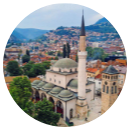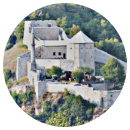Islamic Guide To Bosnia
Country
Bosnia
Cities
Sarajevo - Mostar - Srebrenica - Travnik
Currency
Bosnian Mark
Bosnia is a beautiful Islamic country in the heart of Europe home to medieval villages, rivers & lakes, plus the Dinaric Alps. The capital Sarajevo has well preserved landmarks like 16th-century Gazi Husrev-bey Mosque. Ottoman-era Latin Bridge the site of the assassination of Archduke Franz Ferdinand, which ignited World War I.
SARAJEVO
Sarajevo is the capital of Bosnia & Herzegovina which sits on the Miljacka River, surrounded by the Dinaric Alps. Its home to landmarks of the old quarter, including Baščaršija, the Ottoman-era Gazi Husrev-bey Mosque and Latin Bridge the site of the 1914 assassination of Archduke Franz Ferdinand, an event that sparked World War I.
MOSTAR

Mostar is a city straddling the Neretva River. It’s known for the iconic Stari Most (Old Mostar Bridge), a reconstructed medieval arched bridge and a landmark of the recent Bosnian war. The nearby alleys are full of market stalls and a narrow staircase leads up to the Koski Mehmed-Pasha Mosque’s minaret for panoramic city views.
SREBRENICA
Srebrenica is a small town with a population of 2,604 inhabitants located in the eastern most part of Bosnia & Herzegovina and is still remembered for the Srebrenica massacre, also known as the Srebrenica genocide. In July 1995 genocide of more than 8,000 Bosniaks, mainly Muslim men and boys took place.
TRAVNIK
Travnik became the capital of the Ottoman province of Bosnia and residence of the Bosnian viziers. The historical city became an important center of government in the whole Western frontier of the empire, and consulates were established by various governments and today is the administrative center.
STEP BY STEP GUIDE TO BOSNIA
- Heritage Tours offers 2 tours a year accompanied with renowned Islamic Scholars which take place in April and September.
- To enter Bosnia & Herzegovina, a passport valid for six months beyond the date of arrival is required by and one blank page is needed for the visa.
- Nationals of the following states may enter into Bosnia and Herzegovina with a passport or a valid identity card proving identity and citizenship of:
- Member State of the European Union
- State signatory to the Schengen Agreement
- To apply or check status of your visa eligibility visit ivisa.com/bosnia-visa
- Hygiene in Bosnia & Herzegovina is some of the best standards in the world. The Bosnians are very conscious of cleanliness and purification.
- It is recommended to bring some motion sickness pills for the internal journeys.
- A suggestion on some vaccinations to have for your journey include:
- Hepatitis A / Measles
- The main international airport is in Sarajevo (SJJ).
- The national airline is Fly Bosnia Airways https://flybosnia.ba/ which offers direct flights from major destinations. There are also plenty of indirect fight options with carriers such as Emirates emirates.com, Turkish Airlines www.turkishairlines.com and a range of European airlines.
- Customs forms are required to be completed on arrival for you to declare any currency you are either bringing into, or taking out, along with the amount.
- There are no departure taxes.
- Bosnian Mark is the official currency but US dollars, Euros & GBP are also widely accepted and Bosnia is mainly a cash-based society.
- Credit cards MasterCard & Visa are accepted in major hotels and restaurants.
- ATMs can be found in all major locations.
- Currency exchanges are located around the main cities and a fee is charged for converting.
- Always take your passport with you as proof of ID when exchanging money.
- WIFI services are good offering reliable connectivity.
- Sim cards can be purchased at the airport on arrival or at phone shops and you will require your passport as proof of ID.
- Bosnian, Croatian and Serbian are the main languages spoken in, basic English is also understood at most tourist attractions.
- The three major religions of Bosnia are Roman Catholicism, Serbian Orthodox, and Islam. Bosnian Croats make up the majority of Roman Catholics. Bosnian Serbs make up the majority of the Serbian Orthodox population.
- Bosnian Muslims make up 45% the population, 36% Orthodox, 15% Roman Catholic, 4% Protestant, Jews and other denominations.
- Bosnia and Herzegovina is characterised by its ethnic and religious diversity and visitors should respect the customs and traditions of the various ethnic and religious groups.
- The main ethnic groups are the Bosniaks (48%, also sometimes referred to as Bosnian Muslims), the Serbs (37.1%) and the Croats (14.3%).
- Visitors should be aware that drinking alcohol in public is considered offensive.
- Dominated by mountainous and hilly terrain, and drained by major rivers to the north (Sava) and east (Drina), Bosnia and Herzegovina has a climate that is variable with moderate continental climatic conditions generally the norm (very cold winters and hot summers).
- The best time to visit is during the spring and autumn, with April and September being the absolute optimum month.
- In the winter it can be bitterly cold so bring layers.
- In the summer, it gets very hot so loose, breathable cottons are best.
- Crime level in Bosnia and Herzegovina is generally low.
- Beggars can be seen around the main cities and also be aware of pickpockets.
- Sarajevo is the capital of Bosnia & Herzegovina which sits on the Miljacka River, surrounded by the Dinaric Alps. Its home to landmarks of the old quarter, including Baščaršija, the Ottoman-era Gazi Husrev-bey Mosque and Latin Bridge the site of the 1914 assassination of Archduke Franz Ferdinand, an event that sparked World War I.
- Places to visit:
- Gazi Husrev-beg Mosque – In Sarajevo’s old town was built in 1532 and is the largest historical mosque in the country, and is the centre of the city’s Islamic community. It is exemplary of the Ottoman architecture for which the city is well-known, and is open for tourists to look around.
- Latin Bridge – One of the most well-known events that took place in Sarajevo was the assassination of Archduke Franz Ferdinand, the event that sparked the outbreak of the First World War.
- Tunnel Museum – An integral part to the survival of the Bosniak residents of Sarajevo during the civil war was the Sarajevo Tunnel, which acted as a lifeline to get food, aid, resources, weapons and often people in and out of the city while it was under siege. It was constructed in May 1992 by the Bosnian army, while all routes in and out of the city were blocked of by attacking Serb forces, in order to link up with the UN-controlled area on the other side of the Serbs.
- Sarajevo Town Hall – Easily one of the most stunning examples of architecture from the Austro-Hungarian Empire in Sarajevo is the town hall. Known locally at the Vjećnica, it was built in 1898 but underwent much recent refurbishment as it was a target for the Serbs during the war.
- Baščaršija – Sarajevo’s Old Town is the most historic part of the city, featuring architecture dating from the 15th century. Just as it was in the 15th century, the area is a market and bazaar and today is the cultural centre of the city. Full of narrow cobbled streets, the shops are small and full of character – a mix between Eastern European and Turkish influence. One of its focal points is the main square with its iconic fountain at the centre, if visitors can make it through the hundreds of pigeons to get there. It is home to a great range of traditional restaurants, cafés and coffee houses, so a perfect area to stroll around and explore.
- Mostar is a city straddling the Neretva River. It’s known for the iconic Stari Most (Old Mostar Bridge), a reconstructed medieval arched bridge and a landmark of the recent Bosnian war. The nearby alleys are full of market stalls and a narrow staircase leads up to the Koski Mehmed-Pasha Mosque’s minaret for panoramic city views.
- Places to visit:
- Stari Most – One of Mostar’s and also Bosnia’s most famous sites is the Stari Most, or ‘Old Bridge’. The bridge was built by the Ottomans in the 16th century and is exemplary of typical Islamic architecture and fine engineering. It crosses over the beautiful turquoise Neretva river, and is at the heart of Mostar’s historic Old Town.
- Blagaj Monastery – A short drive south of Mostar is the small village of Blagaj. Within Blagaj is the famous tekija, or monastery, which was founded by Dervish monks in the 16th century. The monastery is nestled at the foot of a cliff face, looking over a beautiful pool, and exemplifies classic Ottoman architecture, with its wooden window frames and overhanging roof.
- Čaršija – In the heart of Mostar’s picturesque Old Town is its market, or čaršija. There is a market on each side of the river near to the Stari Most, due to the split between the Bosniak and Croat ethnic groups that inhabit the city, although the difference between the two is not noticeable to visiting tourists. The market has a distinctly eastern feel, thanks to the historic Ottoman influences, with stalls selling rugs, painted plates, copper items, and souvenirs.
- Kravice Falls – A short drive south of Mostar are the Kravice Falls, some amazing waterfalls near the small town of Kravice. The falls are currently not a well-known attraction amongst tourists, meaning they are peaceful and not yet highly commercialised, although there is a small but useful boardwalk taking visitors closer to the falls.
- Koski Mehmed Paša Mosque – This stunning mosque is not only an attraction itself, but is also a spot for some of the best views of the Stari Most. The mosque was built in the early 1600s by the Ottomans, and today it is one of the best preserved mosques in the area. There is a small entrance fee that includes the climb up the minaret for 360º views of the bridge, and a stroll around the outside courtyard which also offers amazing views.
- War Photo Exhibition – Inside one of Mostar’s historic buildings is a photo gallery, featuring shots taken in Mostar by a New Zealand photographer during the civil war. It is located right next to the Stari Most, and is housed in a traditional dwelling which matches the personal stories of Mostar locals told through the photos.
- Srebrenica is a small town with a population of 2,604 inhabitants located in the eastern most part of Bosnia & Herzegovina and is still remembered for the Srebrenica massacre, also known as the Srebrenica genocide. In July 1995 genocide of more than 8,000 Bosniaks, mainly Muslim men and boys took place.
- Travnik became the capital of the Ottoman province of Bosnia and residence of the Bosnian viziers. The city became an important centre of government in the whole Western frontier of the empire, and consulates were established by various governments and today is the administrative centre.
- Places to visit:
- Stari Grad (Old Town) – A city’s heart and soul usually lies in the historical districts where streets and buildings resist change. Travnik’s Stari Grad has an Ottoman centre with mosques, centuries-old buildings, and Bosnia’s only sundial. Walking through gives a sense of what life is like in the 18th century when Ottoman governors used the area as their official seat of government.
- Travnik Castle – Dates back to pre-Ottoman Bosnia when the former Christian Kingdom ruled the region. The conquering Ottomans later developed and expanded the 14th- or 15th-century castle, transforming it into a fortress with watchtowers. Today, the castle is the best preserved in Bosnia and a national monument, making it a must-do in Travnik for all tourists.
- Jeni Mosque – About one kilometre to the west of Travnik Castle is Travnik’s oldest mosque. Jeni Mosque, completed in 1549 in a classical Ottoman style, predates the official Ottoman Vizier’s seat by more than a century. Every early settlement had at least one central mosque, and Jeni was Travnik’s. Throughout the almost 500-year lifespan, it has been destroyed and rebuilt several times. If you want to appreciate the rich history of the town, Jeni Mosque rates as one of the best things to see in Travnik.
- Sulejmanija Mosque – Colourful murals cover the Many-Coloured Mosque or Ornamented Mosque’s exterior, making it one of the more intriguing Travnik attractions. Built in the 16th century, the colour has since faded. Today, the mosque has three horizontal stripes. Tall arches form the lower and colourful murals decorate the top with a white-washed middle.
- By Train – There are multiple daily trains connecting Samarkand,
- By Rail – The national railway network between the major cities is well connected allowing you view the beauty of the country.
- By Road – Travel by road is the usual means of transport in Bosnia and Herzegovina. During winter and spring, block ice and landslides can make driving difficult.
- By Taxi – There are plenty of reliable taxi services and always use the meter and agree the price before accepting the ride.
- There are a range of hotels to cosy boutique hotels that you can experience across the country.
- Tap water is of good quality and safe to drink.
- Local meat, poultry, seafood, fruit and vegetables are generally considered safe to eat, although it is advisable to peel vegetables and fruit and only eat cooked meat and fish.
- Vegetarian options are available but limited in selection.
Enquire
1
Step 1
keyboard_arrow_leftPrevious
Nextkeyboard_arrow_right



